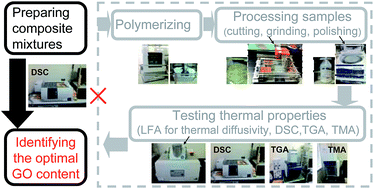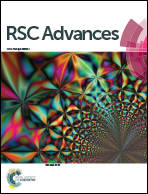Facile identification of the critical content of multi-layer graphene oxide for epoxy composite with optimal thermal properties
Abstract
Multi-layer graphene oxide (MGO) has attracted considerable interest in conductive polymer composites. However, in most cases the optimal MGO content is determined using a complex procedure. Avoiding the complicated work of processing polymerized samples followed by testing various properties, here a facile strategy is proposed to directly identify the critical MGO content among formulations for epoxy composites with optimal thermal properties, simply by monitoring the “unusual” nonlinear MGO content-dependent cure behaviors, as well as the “unusual” pattern of double-peak curing curves. The formation mechanism of the double-peak pattern was explored, with emphasis on studying the epoxy/MGO reaction using a modified Shrinking Core Model. The optimal content determined in this work (2 wt% MGO) was verified by the thermal properties (thermal conductivity, structural thermal stability and coefficient of thermal expansion) of MGO/epoxy composites. Based on the inherent relationship between the effect of MGO percolating chains on the thermal polymerization behavior and the resulting thermal properties, this strategy can be easily extended to different kinds of conductive MGO/polymer composites.


 Please wait while we load your content...
Please wait while we load your content...